The truth about how well your product and business are fairing is in the hands of your customers.
It’s easy to assume you’ve developed a fantastic product, and that’s all that matters, but in the grand scheme of things, your customers are the judge of that.
This is where customer satisfaction surveys play an essential role in your business. With customer satisfaction surveys, you get honest, authentic, and unbiased feedback on how your customers perceive and see your product.
The voice of customer data you get from the surveys is essential to your business. With it, you can mine insights and get valuable feedback you can use to improve your product and customer experience generally.
In this article, we’ll dive deep into what customer satisfaction surveys are, the difference between a customer satisfaction survey and other surveys, types of customer satisfaction surveys, the importance of customer satisfaction surveys, questions to ask in your survey, and different enlightening sections.
Ready to get started?
Let’s dive in.
What Is A Customer Satisfaction Survey?
A customer satisfaction survey is a data collection method (questionnaire) that allows you to compile and measure customer satisfaction rates.
With a customer satisfaction survey, you’re often searching for data on how your customers perceive your product, their experience with your product, the level of performance, and any suggestions they’ve got on how you can improve.
The beautiful thing about customer satisfaction surveys is that it shifts the attention from the business and product to the customer. This means customer satisfaction surveys are user-centric in design.
How Is A Customer Satisfaction Survey Different From Other Customer Surveys?
There are different types of customer surveys out there. Examples are market research surveys, brand awareness surveys, segmentation surveys, event evaluation surveys, etc.
These different survey types serve other purposes.
On the other hand, the customer satisfaction survey is a feedback mechanism that lets a business know how well they’re doing and how satisfied the customer is.
The most common customer satisfaction surveys are usually short answer formats, multiple choice answers, or a rating system.
When you want to carry out a survey, the format you pick will depend on the information you’re looking for.
Suppose you want a performance scale; a rating scale will be the best way to go.
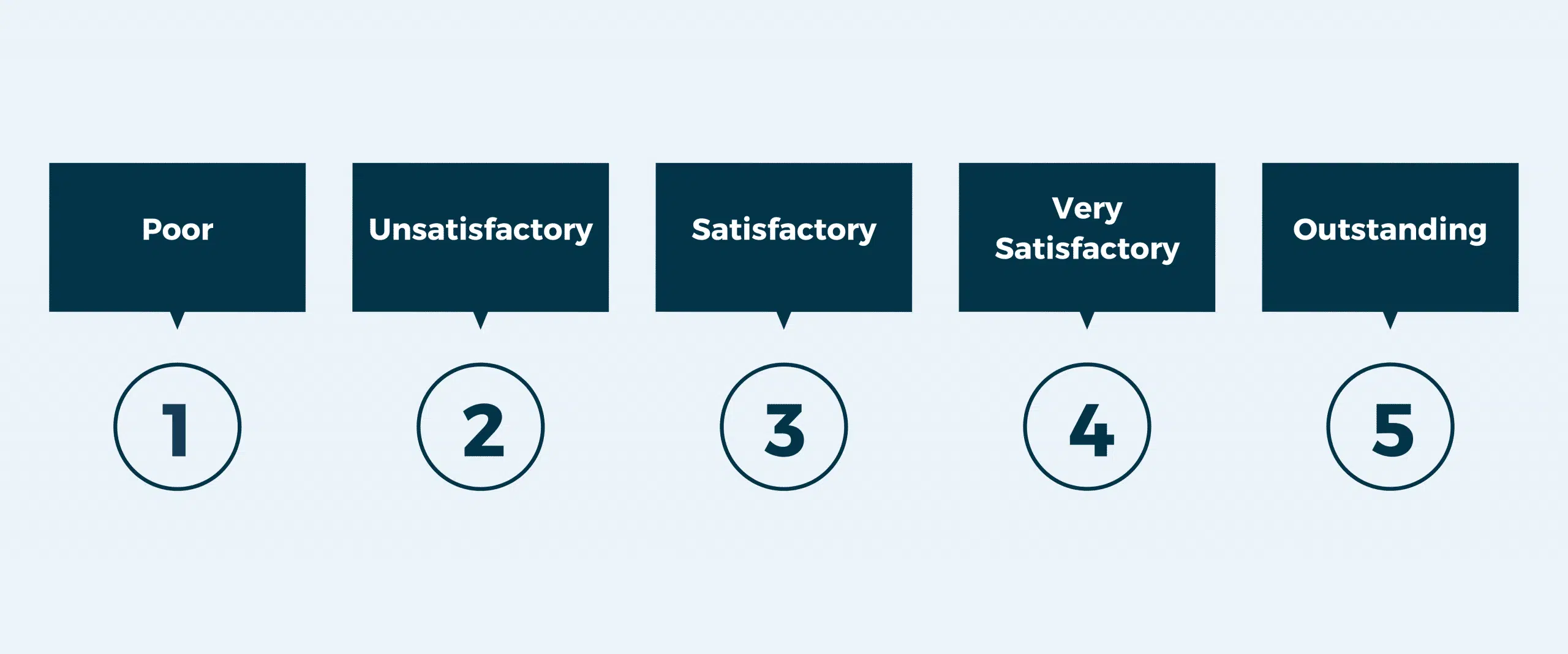
An important factor to note here is that your surveys should be designed in a way that doesn’t require much effort from your participants to fill them.
Types Of Customer Satisfaction Surveys
As a business, instead of assuming your customers are satisfied with your products, there are several ways of finding that out. Customer satisfaction surveys take different forms and these different forms aid in your learning about user experience.
Here are 4 popular customer satisfaction surveys;
1. Customer satisfaction score (CSAT):
This survey type usually contains a yes/no question. Many businesses use this survey after a customer places an order and after using the product for a while.
Here’s an example of a customer satisfaction survey;
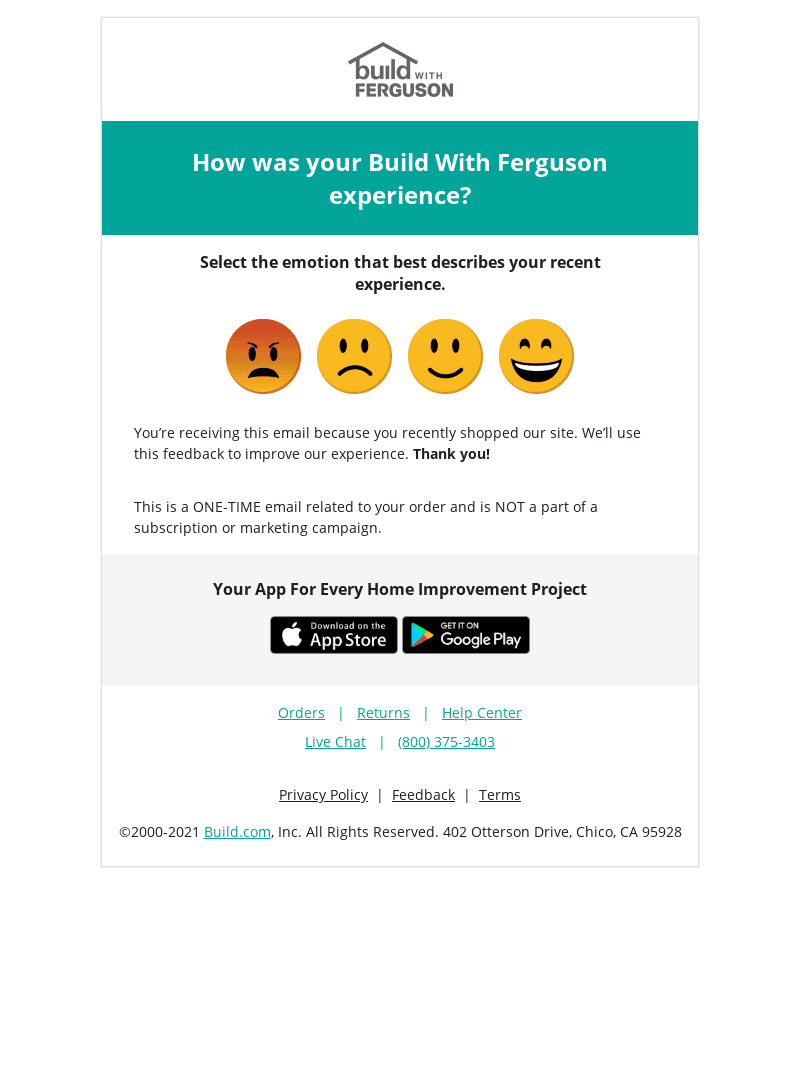
2. Customer Effort Score (CES):
The purpose of this survey is simple. It helps you determine how much effort your customers need to use your product.
This survey is necessary because when a product is difficult to use, customers don’t come back, and when customers don’t come back, sales drop.
Another use for this survey is to find out how helpful and easy it was to fix an issue through your customer support channel.
Here is an example of a customer effort score from Hubspot;
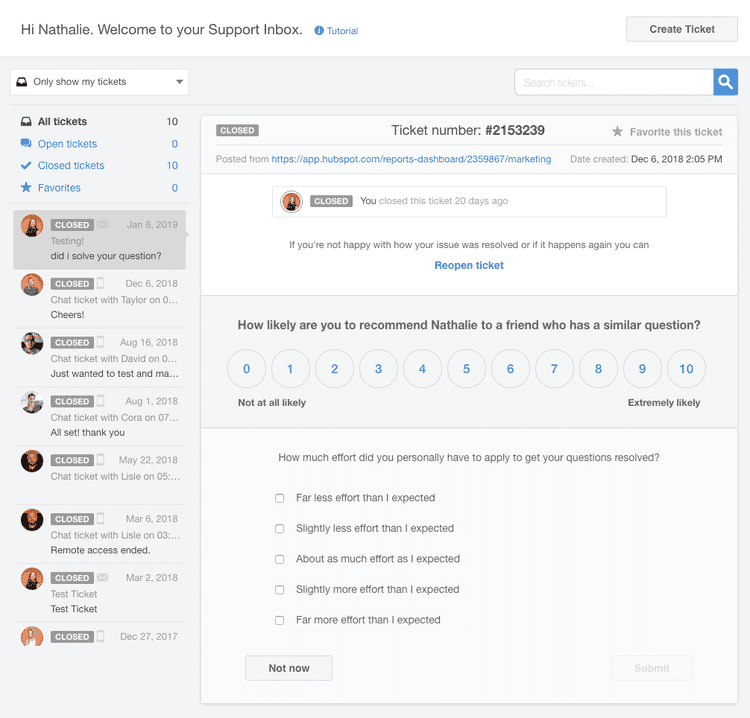
3. Net Promoter Score:
Every business loves a referral, which is the reason for this survey. A Net Promoter Score survey asks customers to rate their likelihood of referring your product to friends, family, and colleagues on a scale of 0-10.
Here’s the formula to calculate your NPS score manually;
number of promoters – number of detractors divided by number of responses multiplied by 100.

Here’s what a Net Promoter Score looks like;
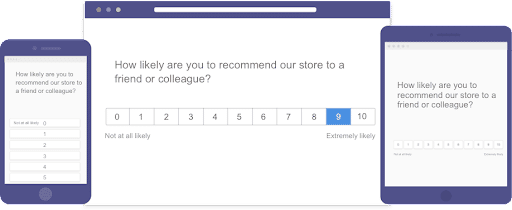
Courtesy: Proprofssurvey
4. Milestone surveys:
This survey is sent out based on certain milestones the user has accomplished with your product.
It differs from business to business. For some, this is sent out after their first purchase; other companies send out this survey after a certain amount is spent to celebrate the customer being with them.
Here’s an example;
On a scale of 1 to 10, how will you rate your experience shopping for our products?
1 – 2 – 3 – 4 – 5 – 6 – 7 – 8 – 9 – 10
The Importance of Customer Satisfaction Surveys.
Customer satisfaction surveys are essential in the customer and business lifecycle for a few reasons;
1. As a business, it lets you know how your customers and potential customers see your product.
2. If you want to know how well your product is doing (experience) and how amazing or not so incredible your business processes are, customer satisfaction surveys help you to know.
3. The feedback you get can help in highlighting areas of improvement.
4. Customer satisfaction survey feedbacks are a good ground for getting ideas for A/B testing and MVT testing.
What Do You Ask In A Customer Satisfaction Survey?
Not every question is fit for a customer satisfaction survey. The reasoning behind this is simple. If you ask questions that don’t focus on customer satisfaction and you get answers, you won’t be getting the correct feedback.
The first step here is not to start writing out your questions but developing a plan or meeting with relevant departments about which data is essential and form your questions around it.
Once you’ve settled which data is essential, picking your questions becomes more effortless.
How Customer Satisfaction Surveys Fit Into Conversion Rate Optimization
Landing more sales and increasing customer retention is what every eCommerce business wants.
Many times, conversion optimization agencies are engaged to help the business increase conversions, which will lead to more sales.
A mature experimentation expert will start by going through customer support tickets to check out complaints and survey answers to get feedback.
This is where the customer satisfaction survey shines.
With the feedback gathered and put into categories, it’s easy to see areas of complaint and create a hypothesis on how to improve the product.
This is how customer satisfaction surveys work with conversion rate optimization. It’s excellent at collecting feedback which can help with the A/B test ideation process.
Creating Your Customer Satisfaction Survey.
When it comes to creating a customer satisfaction survey, there are majorly two approaches to it: the close-ended customer satisfaction survey and the open-ended customer satisfaction survey.
Either approach has its advantages and disadvantages.
Close-ended approach
The close-ended survey approach uses the close-ended question format that doesn’t allow the respondent to fill in the answer they want but work with what’s provided.
1. Multiple Choice Questions:
With this survey type, there’s a limit to the number of answers respondents can give, and it’s a favorite amongst users. The reason is that it takes little to no effort to answer.
A significant advantage of multiple choice questions is that it’s easy to tabulate and get quantitative information.
There are different types of multiple choice questions; rating scale, Likert scale, binary questions, etc.
2. Rating scale:
Rating scale questions, also known as ordinal questions, provide the respondents with answers on a numeric scale to rate how satisfied they were with the checkout experience or rating customer support performance.
Other times, the rating scale doesn’t use numbers to gauge respondents but ordered responses such as satisfied, very satisfied, not satisfied, etc.
Example;
How satisfied are you with our product?
- Extremely satisfied
- Moderately satisfied
- Slightly satisfied
- Neither satisfied nor dissatisfied
- Slightly dissatisfied
- Moderately dissatisfied
- Extremely dissatisfied
3. Likert Scale:
Like the ordinal rating scale, the Likert scale is also a numerical rating scale used to evaluate how users feel about a product or service.
Every question has 5 or 7 answers. The number 1 represents an extreme view, while the number 5 or 7 represents another extreme view.
Also, the Likert scale uses ordered responses like the ordinal scale.
Example;
Overall, how satisfied or dissatisfied are you with the support received today?
- Very satisfied
- Somewhat satisfied
- Neither satisfied nor dissatisfied
- Somewhat dissatisfied
- Very dissatisfied
4. Binary Questions:
The questions in this survey have one of two answers. A yes or a no response. Other times a thumbs up for approval is used or a thumbs down.
Example;
Did you find the product you were looking for today? (Yes/No)
Open-ended Survey Approach
With this approach, the customer satisfaction survey form allows the respondent to fill in their answer to the best of their ability.
This is especially important as it helps uncover improvement areas and gather new ideas.
The major downside to the open-ended survey is that it’s difficult to compute, unlike the close-ended customer satisfaction survey.
Example
What can we do differently to improve the checkout process?
Examples of Questions To Use In Your Customer Satisfaction Survey
Suppose you’ve not developed a customer satisfaction survey before and want to, or you’ve got some templates but want to improve them; the questions below are an excellent place to start.
Close-ended questions:
1. How happy are you with (product name)? (1-5)
- Not happy
- bleh
- As happy as I imagined
- Happy
- Very happy
2. On a scale of 1-5, how would you rate your checkout experience?
3. You just clocked X number of purchases; how will you rate your experience shopping with us?
- Very bad
- Bad
- Needs improvement
- Good
- Very good
4. How likely are you to recommend product X to a friend or colleague? (0 – 10)
5. How easily did our product address your issue?
- Not easily.
- Somewhat easily
- As easy as I had expected
- Easy
- Super cool
Open-ended questions:
1. Do you have anything else to add? Please be 100% honest and specific
2. What can we do to improve the product?
3. If we stopped producing this product, how would you feel?
4. What improvements would you like to see that will persuade you to use product X more often?
5. How could we improve your experience with us as the brand?
How To Create And Distribute Customer Satisfaction Surveys
Suppose you want to start collecting feedback from your site visitors and customers on their experiences with your business; following the steps below will help you get started quickly;
1. Use a template:
There are tons of templates and software that don’t require technical expertise in setting up surveys.
A good one to mention is Figpii. You can easily create polls and surveys and start collecting feedback in under 10 minutes.
2. Decide what to measure, how to measure, and the audience segment to target:
Earlier in this piece, I highlighted some examples of customer satisfaction surveys that, as a business, you can track (NPS, CSAT, etc.). This is where you start by knowing the feedback you want to collect.
The next phase is to determine how you want to collect this data.
- You can make use of pop-up forms
- Send surveys through emails to segmented audiences.
- Install a feedback widget, where site visitors and customers can leave replies
The final step in this stage is to know which part of your audience you want to survey. You can group your audience into different segments like first purchases, renewals, never purchased, long-time customers, etc.
3. Pick an ideal time:
Launching or sending out your survey to your audience whenever you want is a terrible way to go about it.
You need to know when your audience is most active and receptive to your content and launch your survey then. Google Analytics can help with that.
In the case of a customer support survey. This can go out immediately after the call or a few minutes after. This is good because it lets the customer know if the support was of help.
In the case of a first-time customer, you can send a survey after they’ve made their order to know how the checkout process was, and you can also send another survey after they’ve used the product for a while to find out if they’re satisfied.
Other times you can send a survey;
- When a user wants to cancel
- After a user has purchased X amount of times
- Onboarding new customers
Post-Survey: Follow-Up Steps For Your Customer Satisfaction Survey
Now that you have gotten your survey answered and submitted, it’s necessary to follow up with the steps below to maximize the feedback you receive.
1. Thank respondents:
A simple thank you message lets participants know their responses were received and it’s valued. This creates goodwill in them to participate next time if you ever run another survey.
2. Address negative feedback:
Don’t skip over any negative feedback. This is an excellent place to connect with your customers on a personal level and address their concerns. Doing this puts a human touch on your business.
3. Go through every feedback:
This is where it can become tasking. It would help if you went through every feedback, especially the open-ended survey approach. This also allows you to uncover opportunities and address concerns.
4. Address concerns:
At this stage, you want to have a channel or a place where you can upload customer concerns from your surveys and have several teams look into them. Also, at this stage, when you’re going through the feedback and you notice recurring concerns, you can pause the issue you’re collecting the feedback on.
Customer Satisfaction Survey Examples In 2022
1. Nordstrom
One of the world’s leading retailers in fashion items for all age- groups sends out this survey to better understand the customer’s experience with the item. Observing closely, it looks like a kid’s item, so the parent or guardian that got it for the kid will have to ask the kid how they feel about the product before filling out the survey.
This is great because as a parent or guardian, this survey will go a long way to make them feel this brand care for the thoughts of the kids on the items bought.
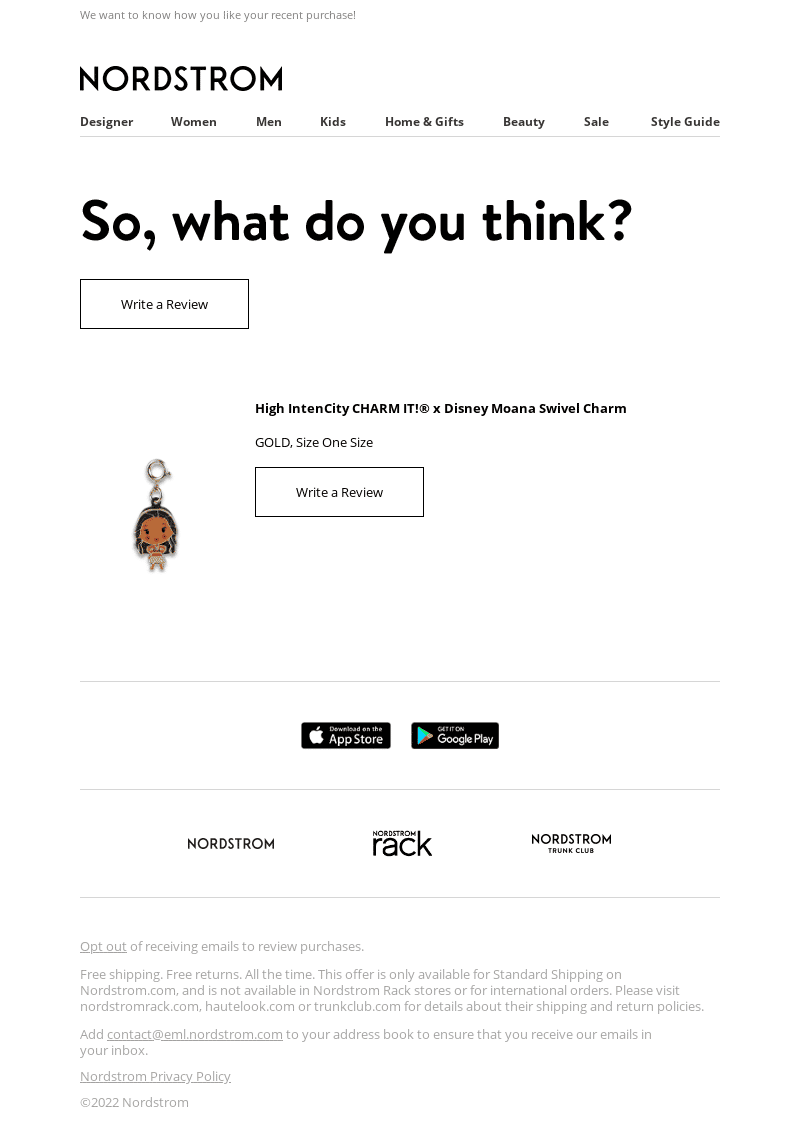 2. 2. Net-A-Porter
2. 2. Net-A-Porter
This is a fashion retail brand that helps women curate amazing designers, and they feature prominent names like Gucci, Saint Laurent, Prada, etc.
Looking at the tone of the message, you’ll notice they take the customers’ perspective seriously.
When writing up your survey copy, you want to make sure your customers know you value their feedback.
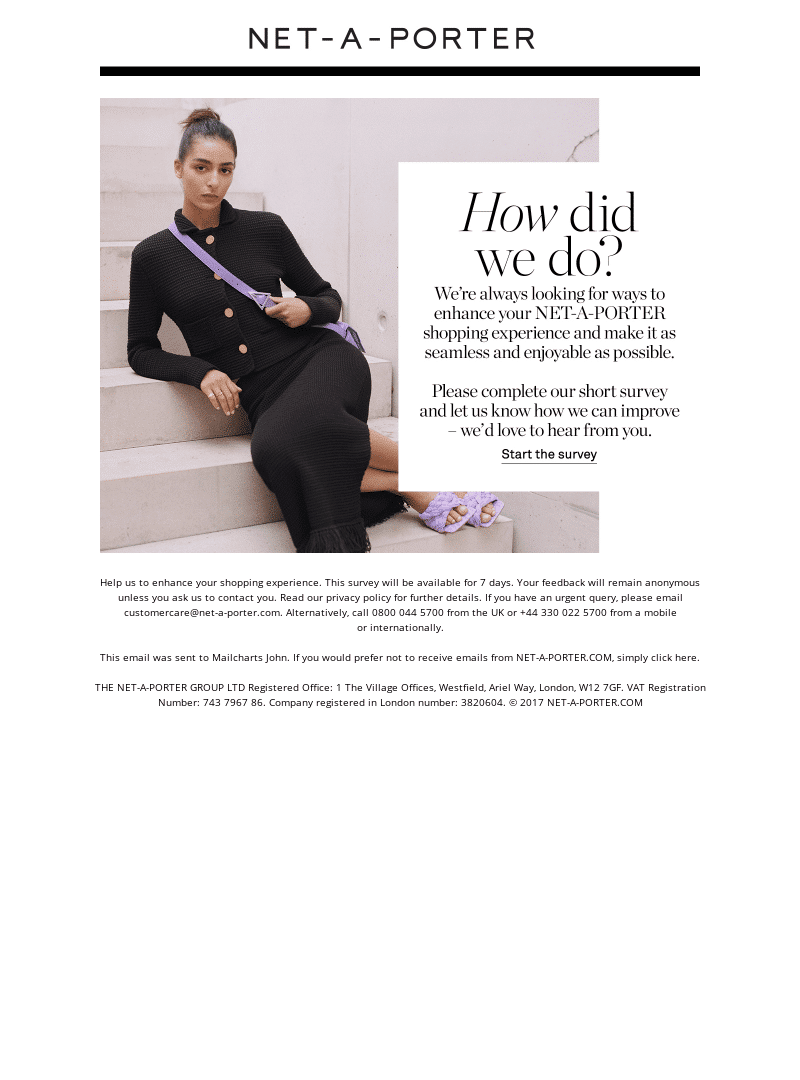
3. CatLadyBox
This is a subscription brand for cat moms and lovers; they send cat-themed items monthly.
Reading through the message before the survey button, you’ll notice they’re looking for honest feedback from their customers and will most likely use the feedback to improve their product.
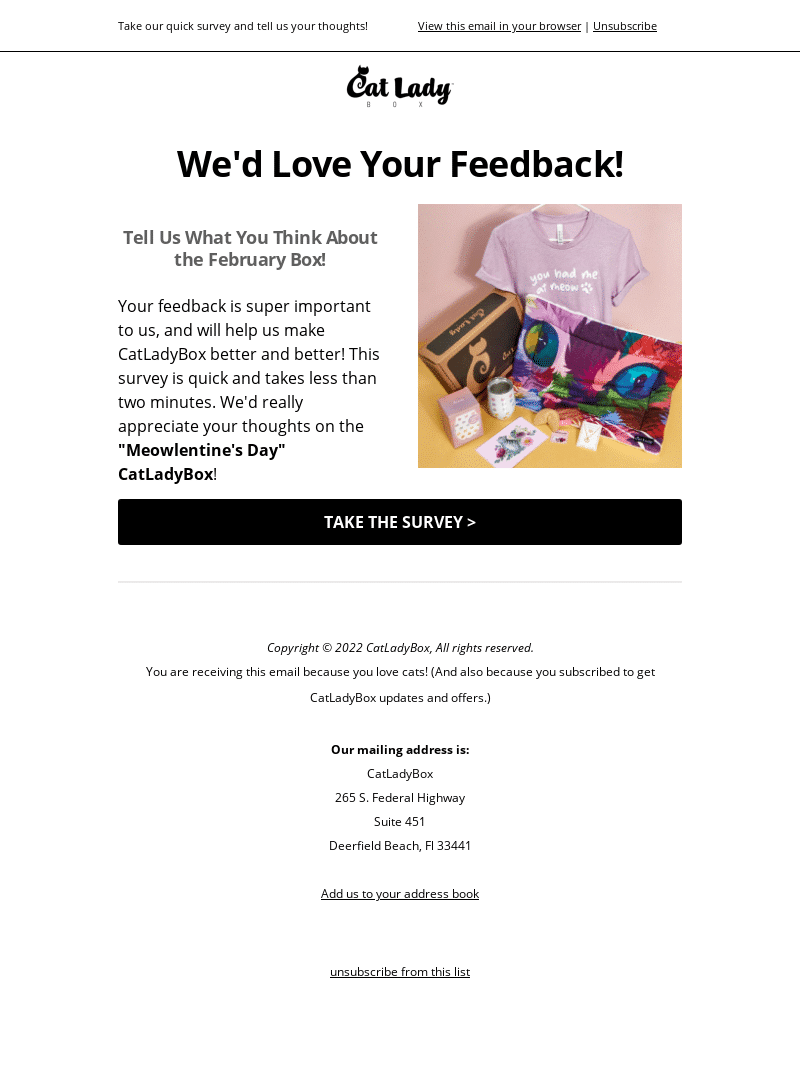
4. QuikSilver
This leading surfing brand delivers amazing gears and products to surfers.
One striking thing about the messaging before the survey is that they knew and acknowledged that the customer had to have used the product to give good feedback.
Note: sending out a customer satisfaction survey before your customers get to use your product won’t give you quality insights you can use.
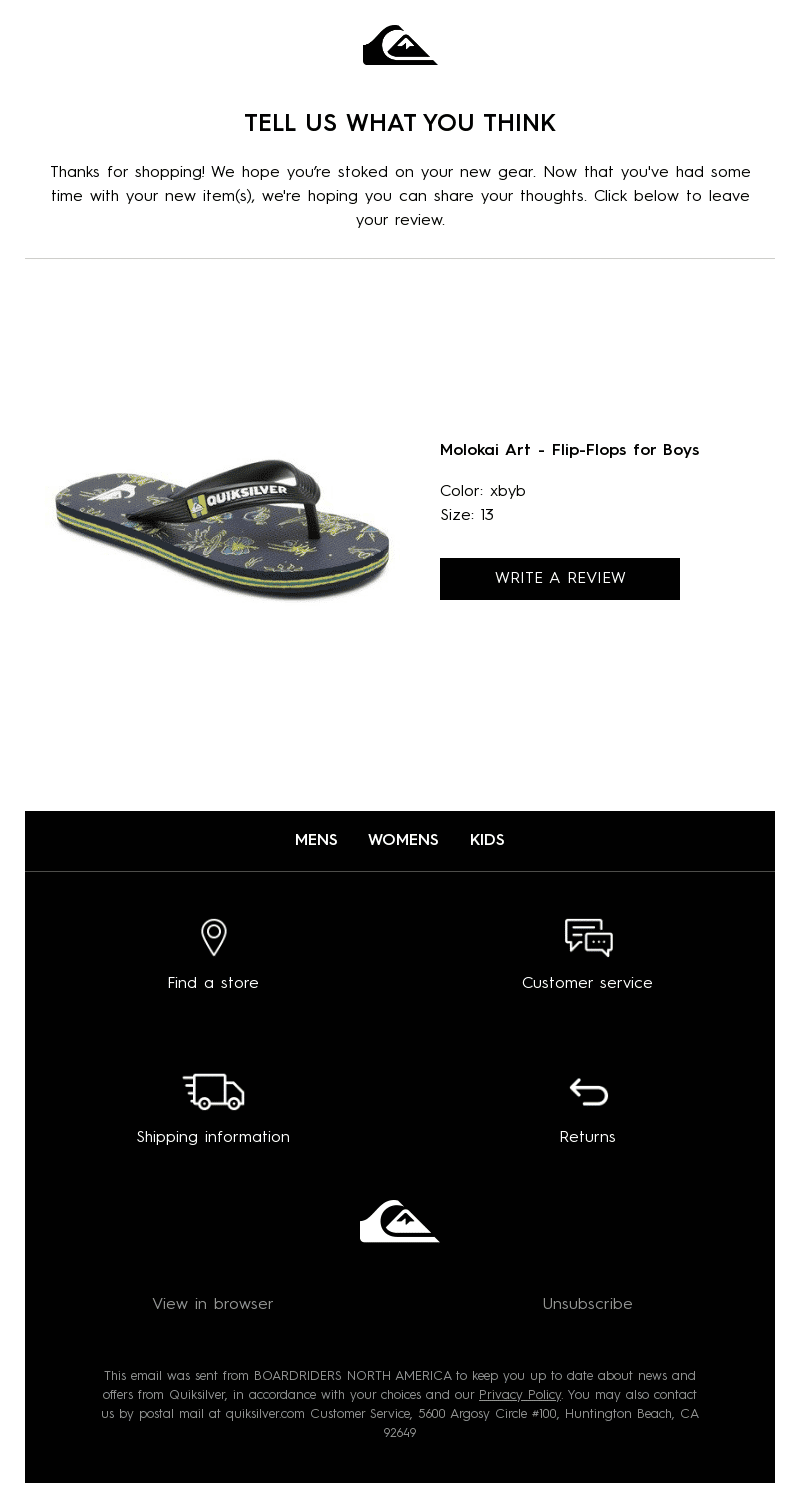
5. MyBillie
Billie is a razor shaving brand for women that promises a fantastic experience, and their products come in beautiful colors.
They make use of a Likert scale but not ordered responses, you’ve got to check a start to give a rating.
Customers easily fill these surveys because it’s quick to the point.
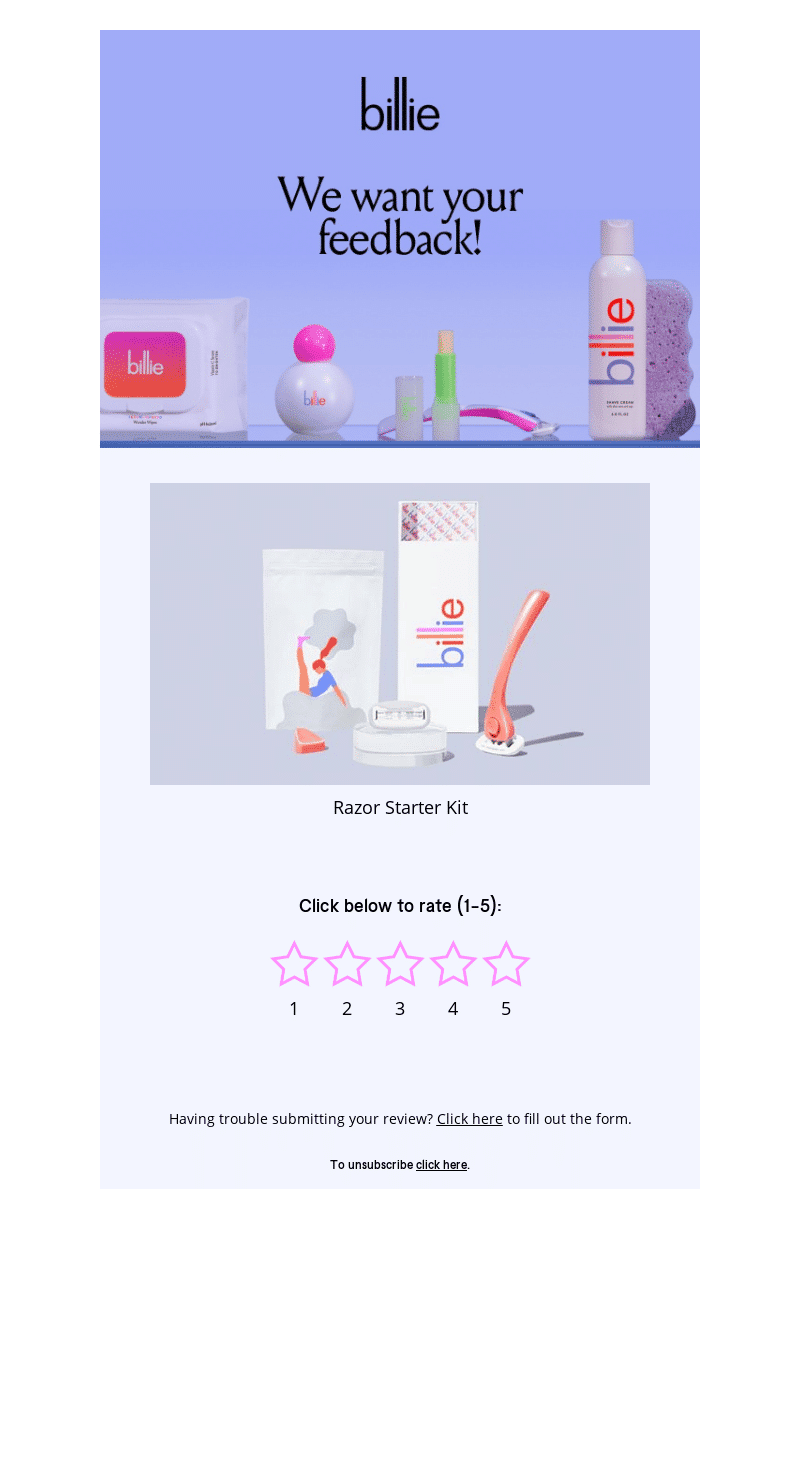
Wrapping Up
Every business wants to stay top of mind for their customers but that’s only achievable when your product evolves to meet the ever-changing need of your customers.
One way to stay ahead of trends and satisfy customers is by always collecting satisfaction feedback every step of the way.
This way, you know what’s working, what needs to be improved, and what you need to develop if need be.
When you implement the feedback gathered, you’ll easily stay top of mind and stay ahead of the competition.



